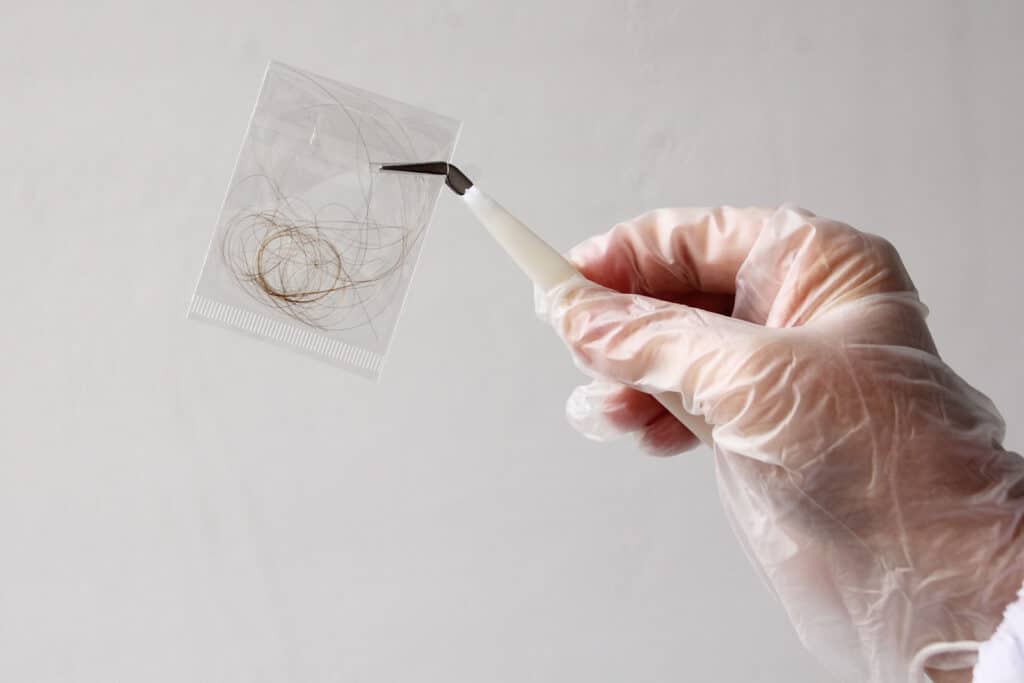The presence of alcohol can be detected through several tests, including blood, urine, and hair. Each has advantages and disadvantages. A big advantage of hair alcohol testing is the detection window. A hair alcohol test can detect alcohol consumption over a much longer period compared to the other methods.
Table of Contents
- 1 UNDERSTANDING HAIR ALCOHOL TESTING
- 2 ALCOHOL AND THE HAIR FOLLICLE
- 3 DETECTION WINDOW FOR ALCOHOL IN HAIR
- 4 TYPES OF ALCOHOL TESTS FOR HAIR
- 5 ACCURACY AND RELIABILITY
- 6 FACTORS AFFECTING TEST RESULTS
- 7 USES OF HAIR ALCOHOL TESTING
- 8 LEGAL AND ETHICAL CONSIDERATIONS
- 9 PREPARING FOR A HAIR ALCOHOL TEST
- 10 FUTURE OF HAIR ALCOHOL TESTING
- 11 References
UNDERSTANDING HAIR ALCOHOL TESTING
A hair alcohol test evaluates strands of hair for the presence of two alcohol metabolites: ethyl glucuronide (EtG) and fatty acid ethyl esters (FAEEs). When a person consumes alcohol, it gets broken down into these metabolites, which enter the bloodstream. Since blood nourishes hair follicles, these metabolites get deposited into the hair, creating a record of alcohol use.
ALCOHOL AND THE HAIR FOLLICLE
Alcoholic beverages get metabolized in the body, and the metabolites produced by this process circulate in the bloodstream, including to the hair follicles, where blood is required to make the hair grow. Some of these metabolites get cleaved off and embedded into individual hair strands, where they remain until the hair is cut. This enables testing for alcohol use over a longer period.

DETECTION WINDOW FOR ALCOHOL IN HAIR
Hair testing typically provides a detection window of 90 days or more, but the exact time can vary based on several factors, such as hair growth rate, hair color, and alcohol consumption patterns. For instance, people with fast-growing hair or light hair colors often have shorter detection windows, as do people with a history of heavy alcohol consumption.
| Type of Alcohol Test | Detection Window |
|---|---|
| Ethyl Glucuronide (EtG) Hair Test | Up to 90 days |
| Fatty Acid Ethyl Esters (FAEE) Hair Test | Up to 90 days |
- Ethyl Glucuronide (EtG) Hair Test: This test looks for EtG, a direct metabolite of alcohol. It can typically detect alcohol use for up to 90 days after consumption.
- Fatty Acid Ethyl Esters (FAEE) Hair Test: This test checks for FAEEs, which are also metabolites of alcohol. Like the EtG test, it can identify alcohol use for up to 90 days.
TYPES OF ALCOHOL TESTS FOR HAIR
The most common type of hair alcohol test is an EtG test, which checks for the presence of ethyl glucuronide, the most salient of the metabolites produced when the body processes alcohol. Other tests check for different alcohol metabolites, such as FAEEs, but the EtG test is considered the gold standard and is the most commonly used.
Hair alcohol tests are distinct from tests for other substances as they target alcohol-specific metabolites. Since these metabolites have no way of entering the body without alcohol consumption, hair alcohol tests are highly accurate, and false positives are rare.
ACCURACY AND RELIABILITY
Hair alcohol testing is highly accurate for detecting long-term or chronic alcohol consumption. For recent or sporadic use, it’s a bit less reliable. For instance, if a person has a beer during a ballgame or a glass of wine with dinner and submits to a hair alcohol test, their consumption might not be detected since the metabolites produced by such a small amount of alcohol likely wouldn’t be enough for the test to pick up. A urine or blood test is a better option for detecting recent or light alcohol consumption.
FACTORS AFFECTING TEST RESULTS
Both external and biological factors can impact hair alcohol test results. External factors such as hair dyes and treatments can reduce the accuracy of the test by introducing contaminants that mask or obscure the presence of alcohol metabolites. In rare cases, a person who doesn’t consume alcohol but is exposed to alcohol vapors might get a false positive.
Several biological factors, such as a person’s hair structure or rate of alcohol metabolism, can impact the test by influencing the retention of metabolites in hair.
USES OF HAIR ALCOHOL TESTING
Hair alcohol testing can be useful for employment screening, medical diagnostics, and legal cases. Because this type of test is most effective at picking up on the type of long-term consumption associated with alcoholism and chronic use, employers might find it useful for identifying if a job applicant is a problem drinker. Doctors can use it as part of a broader screening to gauge a patient’s risk for alcohol-related health problems. Even lawyers are known to use hair alcohol testing to establish patterns of alcohol use when prosecuting or defending cases.
Although hair alcohol testing provides the best historical perspective of any detection method, it might not be the most accurate choice in situations where recent alcohol use needs to be established, such as during a DUI investigation.

LEGAL AND ETHICAL CONSIDERATIONS
Depending on the jurisdiction, hair alcohol testing might or might not be admissible in court. Anyone planning to use it in a legal setting should make sure they understand the legal implications of doing so.
Civil liberties advocates have raised ethical concerns surrounding the use of hair alcohol testing. The long detection window associated with the test and its inability to pinpoint the exact time or amount in which alcohol was consumed have led to privacy concerns, especially since alcohol is legal for those 21 and older.
PREPARING FOR A HAIR ALCOHOL TEST
Individuals preparing for a hair alcohol test should be aware of the long detection window, especially in the weeks leading up to the test, assuming advance notice was given. They should also avoid tampering with their hair or using harsh chemicals before the test, as this can alter the results and lead to charges of obfuscation.
The testing process itself is simple and straightforward. A small hair sample will be taken from the scalp (if a person is bald, the hair can come from another part of the body) and analyzed for alcohol metabolites. The amount of hair taken is not enough for anyone to notice.
FUTURE OF HAIR ALCOHOL TESTING
Improvements are underway for hair alcohol testing. Future versions of the test could have even longer detection windows and be less vulnerable to the impact of external factors such as hair dyes. Looking further down the road, the tests could be refined even more in a society of hair testing and used in broader fields and contexts, such as personalized medicine.
To recap, hair alcohol testing is a highly accurate way to detect alcohol consumption over a long time or amount of time–a window of 90 days or more, but it’s less reliable at picking up on recent or sporadic use.
Considering its strengths but also its limitations and potential legal and ethical concerns, this testing method should be used judiciously.
References
Published on: 2023-12-27
Updated on: 2025-02-07



